Exploring Formal and Informal Attire: An In-Depth Comparison Essay
VerifiedAdded on 2023/06/07
|6
|1463
|453
Essay
AI Summary
This essay provides a comprehensive comparison between formal and informal attire, delving into their distinct characteristics and similarities. It highlights the occasions for wearing each type, such as formal events like weddings and business meetings for formal attire, and everyday wear for inform...
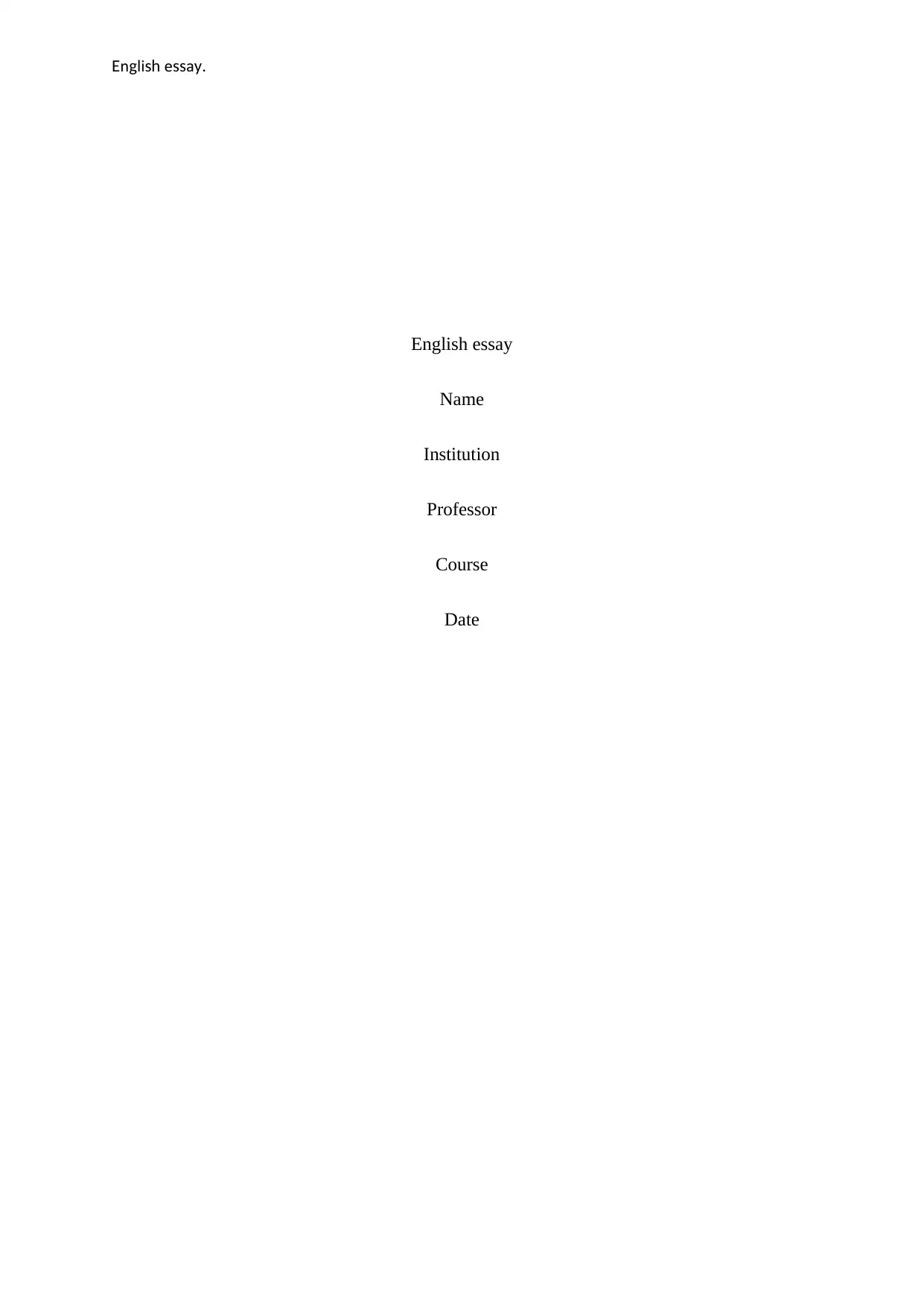
n li e aE g sh ss y.
English essay
Name
Institution
Professor
Course
Date
English essay
Name
Institution
Professor
Course
Date
Paraphrase This Document
Need a fresh take? Get an instant paraphrase of this document with our AI Paraphraser
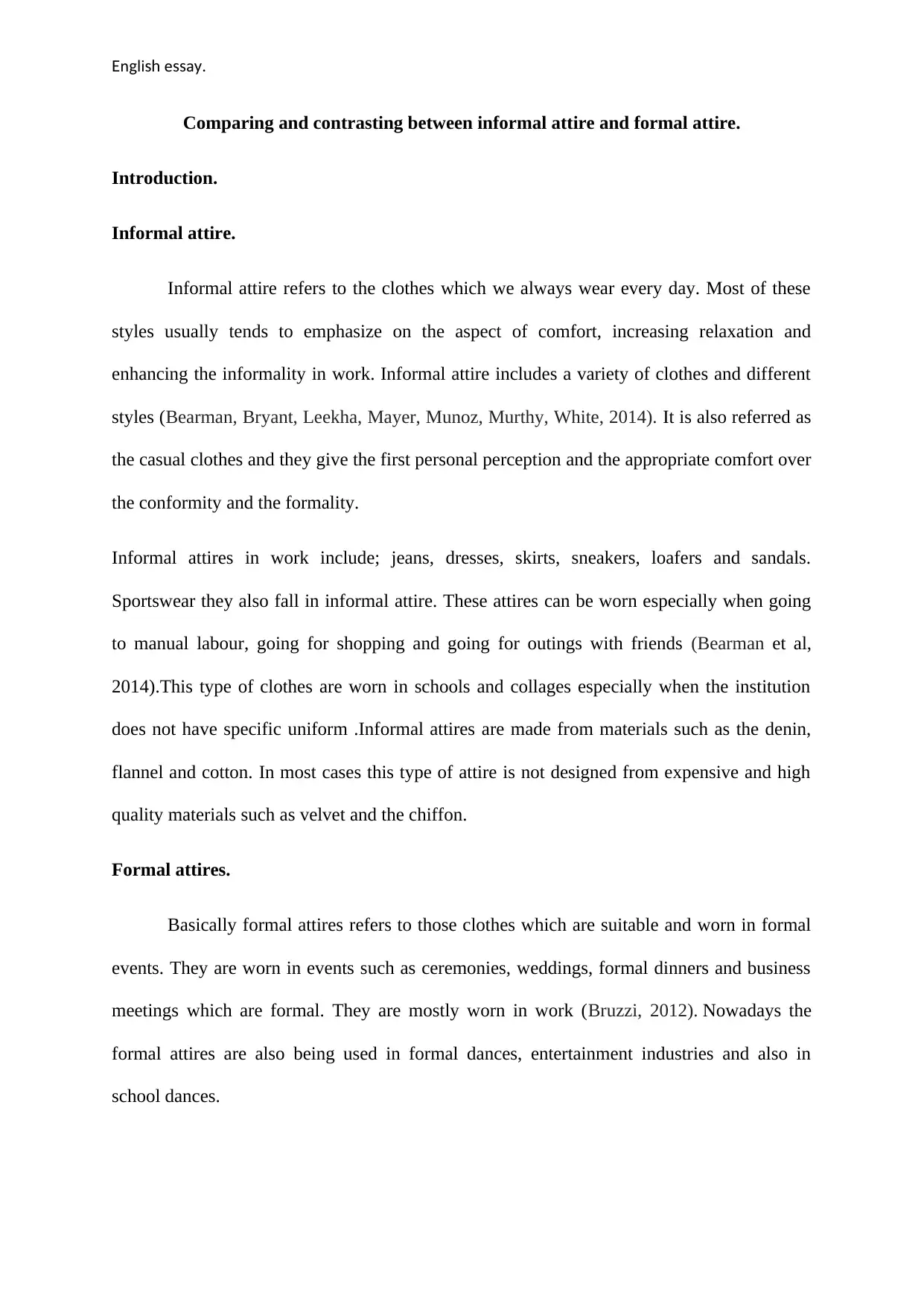
n li e aE g sh ss y.
Comparing and contrasting between informal attire and formal attire.
Introduction.
Informal attire.
Informal attire refers to the clothes which we always wear every day. Most of these
styles usually tends to emphasize on the aspect of comfort, increasing relaxation and
enhancing the informality in work. Informal attire includes a variety of clothes and different
styles (Bearman, Bryant, Leekha, Mayer, Munoz, Murthy, White, 2014). It is also referred as
the casual clothes and they give the first personal perception and the appropriate comfort over
the conformity and the formality.
Informal attires in work include; jeans, dresses, skirts, sneakers, loafers and sandals.
Sportswear they also fall in informal attire. These attires can be worn especially when going
to manual labour, going for shopping and going for outings with friends (Bearman et al,
2014).This type of clothes are worn in schools and collages especially when the institution
does not have specific uniform .Informal attires are made from materials such as the denin,
flannel and cotton. In most cases this type of attire is not designed from expensive and high
quality materials such as velvet and the chiffon.
Formal attires.
Basically formal attires refers to those clothes which are suitable and worn in formal
events. They are worn in events such as ceremonies, weddings, formal dinners and business
meetings which are formal. They are mostly worn in work (Bruzzi, 2012). Nowadays the
formal attires are also being used in formal dances, entertainment industries and also in
school dances.
Comparing and contrasting between informal attire and formal attire.
Introduction.
Informal attire.
Informal attire refers to the clothes which we always wear every day. Most of these
styles usually tends to emphasize on the aspect of comfort, increasing relaxation and
enhancing the informality in work. Informal attire includes a variety of clothes and different
styles (Bearman, Bryant, Leekha, Mayer, Munoz, Murthy, White, 2014). It is also referred as
the casual clothes and they give the first personal perception and the appropriate comfort over
the conformity and the formality.
Informal attires in work include; jeans, dresses, skirts, sneakers, loafers and sandals.
Sportswear they also fall in informal attire. These attires can be worn especially when going
to manual labour, going for shopping and going for outings with friends (Bearman et al,
2014).This type of clothes are worn in schools and collages especially when the institution
does not have specific uniform .Informal attires are made from materials such as the denin,
flannel and cotton. In most cases this type of attire is not designed from expensive and high
quality materials such as velvet and the chiffon.
Formal attires.
Basically formal attires refers to those clothes which are suitable and worn in formal
events. They are worn in events such as ceremonies, weddings, formal dinners and business
meetings which are formal. They are mostly worn in work (Bruzzi, 2012). Nowadays the
formal attires are also being used in formal dances, entertainment industries and also in
school dances.
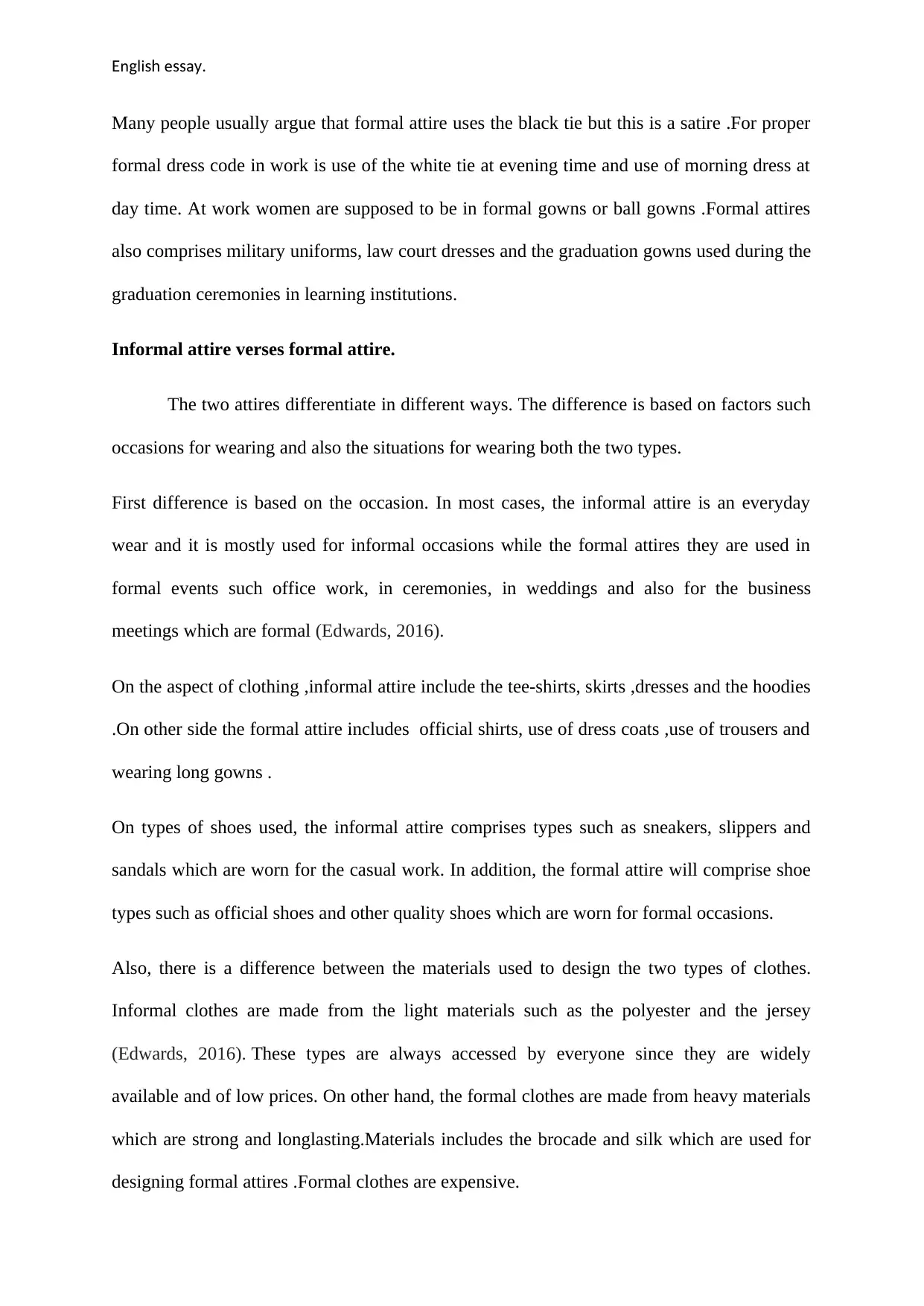
n li e aE g sh ss y.
Many people usually argue that formal attire uses the black tie but this is a satire .For proper
formal dress code in work is use of the white tie at evening time and use of morning dress at
day time. At work women are supposed to be in formal gowns or ball gowns .Formal attires
also comprises military uniforms, law court dresses and the graduation gowns used during the
graduation ceremonies in learning institutions.
Informal attire verses formal attire.
The two attires differentiate in different ways. The difference is based on factors such
occasions for wearing and also the situations for wearing both the two types.
First difference is based on the occasion. In most cases, the informal attire is an everyday
wear and it is mostly used for informal occasions while the formal attires they are used in
formal events such office work, in ceremonies, in weddings and also for the business
meetings which are formal (Edwards, 2016).
On the aspect of clothing ,informal attire include the tee-shirts, skirts ,dresses and the hoodies
.On other side the formal attire includes official shirts, use of dress coats ,use of trousers and
wearing long gowns .
On types of shoes used, the informal attire comprises types such as sneakers, slippers and
sandals which are worn for the casual work. In addition, the formal attire will comprise shoe
types such as official shoes and other quality shoes which are worn for formal occasions.
Also, there is a difference between the materials used to design the two types of clothes.
Informal clothes are made from the light materials such as the polyester and the jersey
(Edwards, 2016). These types are always accessed by everyone since they are widely
available and of low prices. On other hand, the formal clothes are made from heavy materials
which are strong and longlasting.Materials includes the brocade and silk which are used for
designing formal attires .Formal clothes are expensive.
Many people usually argue that formal attire uses the black tie but this is a satire .For proper
formal dress code in work is use of the white tie at evening time and use of morning dress at
day time. At work women are supposed to be in formal gowns or ball gowns .Formal attires
also comprises military uniforms, law court dresses and the graduation gowns used during the
graduation ceremonies in learning institutions.
Informal attire verses formal attire.
The two attires differentiate in different ways. The difference is based on factors such
occasions for wearing and also the situations for wearing both the two types.
First difference is based on the occasion. In most cases, the informal attire is an everyday
wear and it is mostly used for informal occasions while the formal attires they are used in
formal events such office work, in ceremonies, in weddings and also for the business
meetings which are formal (Edwards, 2016).
On the aspect of clothing ,informal attire include the tee-shirts, skirts ,dresses and the hoodies
.On other side the formal attire includes official shirts, use of dress coats ,use of trousers and
wearing long gowns .
On types of shoes used, the informal attire comprises types such as sneakers, slippers and
sandals which are worn for the casual work. In addition, the formal attire will comprise shoe
types such as official shoes and other quality shoes which are worn for formal occasions.
Also, there is a difference between the materials used to design the two types of clothes.
Informal clothes are made from the light materials such as the polyester and the jersey
(Edwards, 2016). These types are always accessed by everyone since they are widely
available and of low prices. On other hand, the formal clothes are made from heavy materials
which are strong and longlasting.Materials includes the brocade and silk which are used for
designing formal attires .Formal clothes are expensive.
⊘ This is a preview!⊘
Do you want full access?
Subscribe today to unlock all pages.

Trusted by 1+ million students worldwide
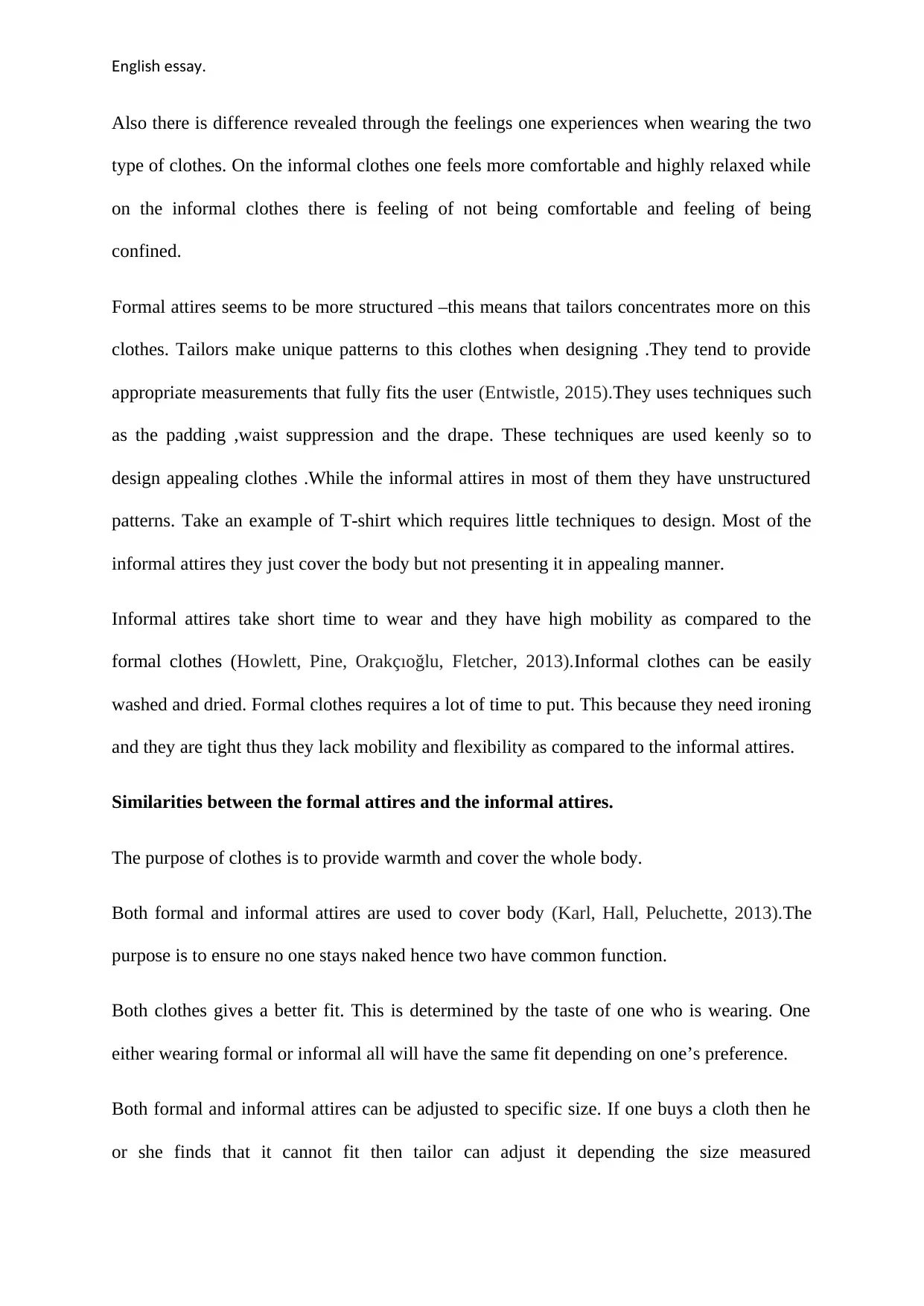
n li e aE g sh ss y.
Also there is difference revealed through the feelings one experiences when wearing the two
type of clothes. On the informal clothes one feels more comfortable and highly relaxed while
on the informal clothes there is feeling of not being comfortable and feeling of being
confined.
Formal attires seems to be more structured –this means that tailors concentrates more on this
clothes. Tailors make unique patterns to this clothes when designing .They tend to provide
appropriate measurements that fully fits the user (Entwistle, 2015).They uses techniques such
as the padding ,waist suppression and the drape. These techniques are used keenly so to
design appealing clothes .While the informal attires in most of them they have unstructured
patterns. Take an example of T-shirt which requires little techniques to design. Most of the
informal attires they just cover the body but not presenting it in appealing manner.
Informal attires take short time to wear and they have high mobility as compared to the
formal clothes (Howlett, Pine, Orakçıoğlu, Fletcher, 2013).Informal clothes can be easily
washed and dried. Formal clothes requires a lot of time to put. This because they need ironing
and they are tight thus they lack mobility and flexibility as compared to the informal attires.
Similarities between the formal attires and the informal attires.
The purpose of clothes is to provide warmth and cover the whole body.
Both formal and informal attires are used to cover body (Karl, Hall, Peluchette, 2013).The
purpose is to ensure no one stays naked hence two have common function.
Both clothes gives a better fit. This is determined by the taste of one who is wearing. One
either wearing formal or informal all will have the same fit depending on one’s preference.
Both formal and informal attires can be adjusted to specific size. If one buys a cloth then he
or she finds that it cannot fit then tailor can adjust it depending the size measured
Also there is difference revealed through the feelings one experiences when wearing the two
type of clothes. On the informal clothes one feels more comfortable and highly relaxed while
on the informal clothes there is feeling of not being comfortable and feeling of being
confined.
Formal attires seems to be more structured –this means that tailors concentrates more on this
clothes. Tailors make unique patterns to this clothes when designing .They tend to provide
appropriate measurements that fully fits the user (Entwistle, 2015).They uses techniques such
as the padding ,waist suppression and the drape. These techniques are used keenly so to
design appealing clothes .While the informal attires in most of them they have unstructured
patterns. Take an example of T-shirt which requires little techniques to design. Most of the
informal attires they just cover the body but not presenting it in appealing manner.
Informal attires take short time to wear and they have high mobility as compared to the
formal clothes (Howlett, Pine, Orakçıoğlu, Fletcher, 2013).Informal clothes can be easily
washed and dried. Formal clothes requires a lot of time to put. This because they need ironing
and they are tight thus they lack mobility and flexibility as compared to the informal attires.
Similarities between the formal attires and the informal attires.
The purpose of clothes is to provide warmth and cover the whole body.
Both formal and informal attires are used to cover body (Karl, Hall, Peluchette, 2013).The
purpose is to ensure no one stays naked hence two have common function.
Both clothes gives a better fit. This is determined by the taste of one who is wearing. One
either wearing formal or informal all will have the same fit depending on one’s preference.
Both formal and informal attires can be adjusted to specific size. If one buys a cloth then he
or she finds that it cannot fit then tailor can adjust it depending the size measured
Paraphrase This Document
Need a fresh take? Get an instant paraphrase of this document with our AI Paraphraser
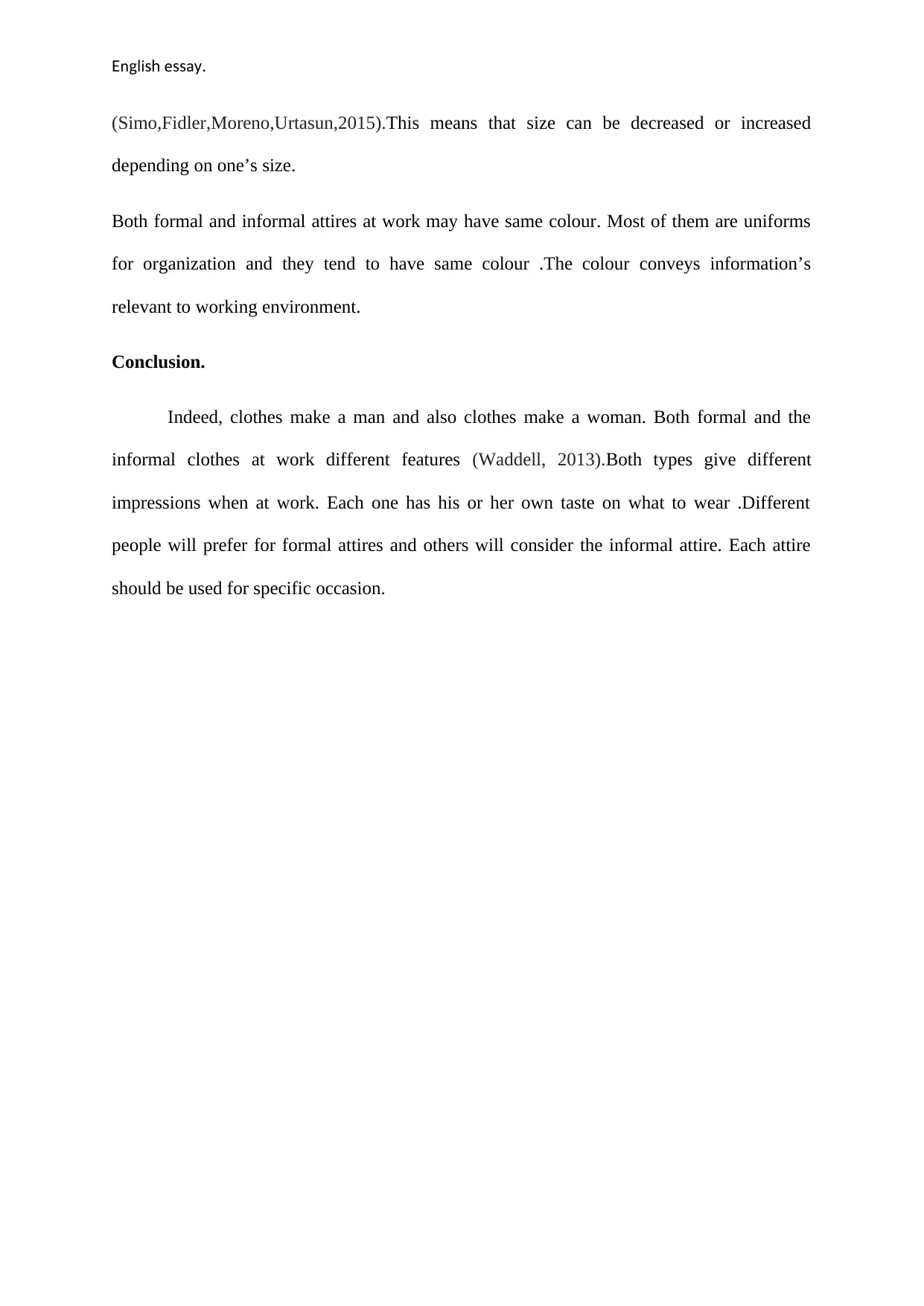
n li e aE g sh ss y.
(Simo,Fidler,Moreno,Urtasun,2015).This means that size can be decreased or increased
depending on one’s size.
Both formal and informal attires at work may have same colour. Most of them are uniforms
for organization and they tend to have same colour .The colour conveys information’s
relevant to working environment.
Conclusion.
Indeed, clothes make a man and also clothes make a woman. Both formal and the
informal clothes at work different features (Waddell, 2013).Both types give different
impressions when at work. Each one has his or her own taste on what to wear .Different
people will prefer for formal attires and others will consider the informal attire. Each attire
should be used for specific occasion.
(Simo,Fidler,Moreno,Urtasun,2015).This means that size can be decreased or increased
depending on one’s size.
Both formal and informal attires at work may have same colour. Most of them are uniforms
for organization and they tend to have same colour .The colour conveys information’s
relevant to working environment.
Conclusion.
Indeed, clothes make a man and also clothes make a woman. Both formal and the
informal clothes at work different features (Waddell, 2013).Both types give different
impressions when at work. Each one has his or her own taste on what to wear .Different
people will prefer for formal attires and others will consider the informal attire. Each attire
should be used for specific occasion.
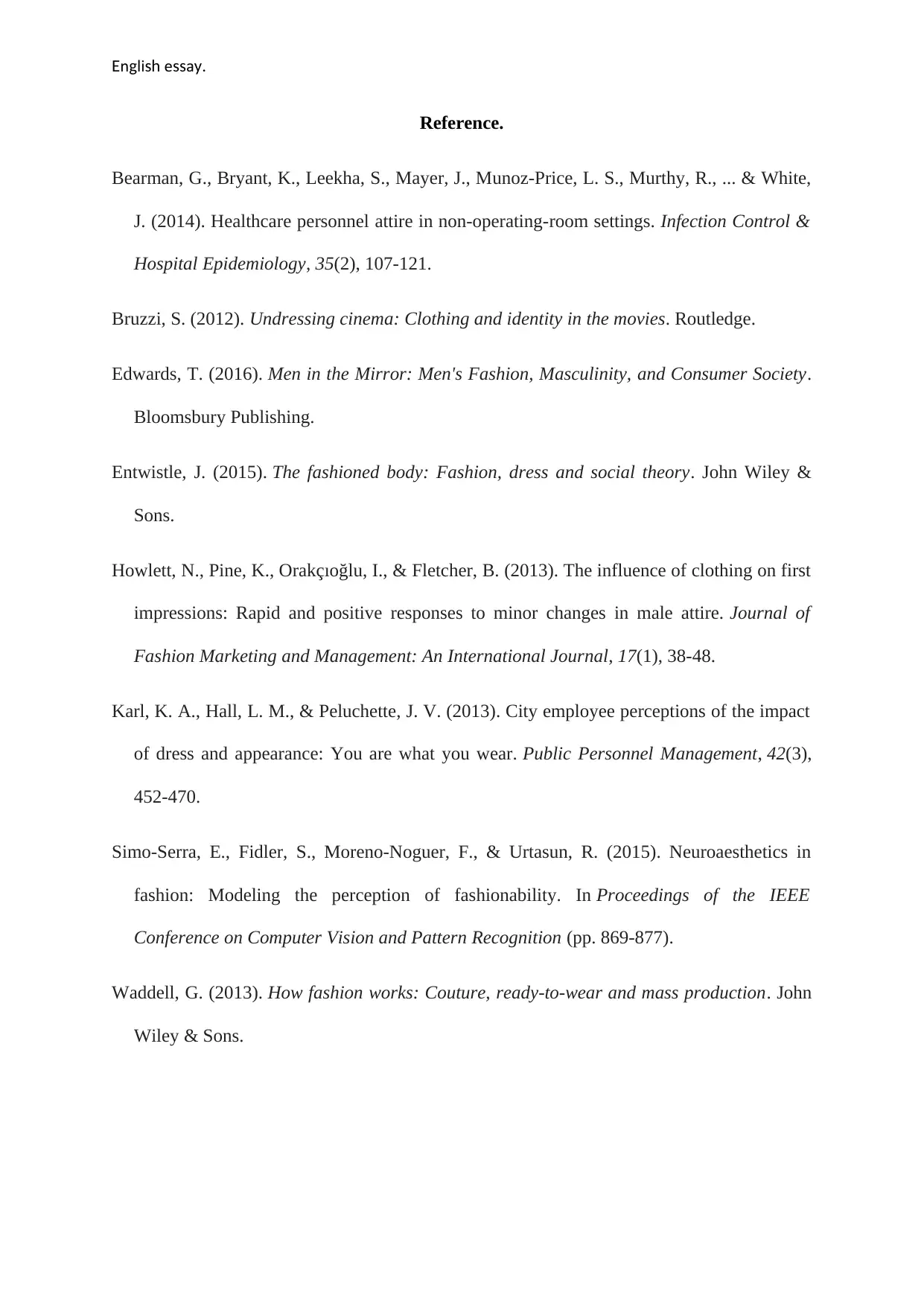
n li e aE g sh ss y.
Reference.
Bearman, G., Bryant, K., Leekha, S., Mayer, J., Munoz-Price, L. S., Murthy, R., ... & White,
J. (2014). Healthcare personnel attire in non-operating-room settings. Infection Control &
Hospital Epidemiology, 35(2), 107-121.
Bruzzi, S. (2012). Undressing cinema: Clothing and identity in the movies. Routledge.
Edwards, T. (2016). Men in the Mirror: Men's Fashion, Masculinity, and Consumer Society.
Bloomsbury Publishing.
Entwistle, J. (2015). The fashioned body: Fashion, dress and social theory. John Wiley &
Sons.
Howlett, N., Pine, K., Orakçıoğlu, I., & Fletcher, B. (2013). The influence of clothing on first
impressions: Rapid and positive responses to minor changes in male attire. Journal of
Fashion Marketing and Management: An International Journal, 17(1), 38-48.
Karl, K. A., Hall, L. M., & Peluchette, J. V. (2013). City employee perceptions of the impact
of dress and appearance: You are what you wear. Public Personnel Management, 42(3),
452-470.
Simo-Serra, E., Fidler, S., Moreno-Noguer, F., & Urtasun, R. (2015). Neuroaesthetics in
fashion: Modeling the perception of fashionability. In Proceedings of the IEEE
Conference on Computer Vision and Pattern Recognition (pp. 869-877).
Waddell, G. (2013). How fashion works: Couture, ready-to-wear and mass production. John
Wiley & Sons.
Reference.
Bearman, G., Bryant, K., Leekha, S., Mayer, J., Munoz-Price, L. S., Murthy, R., ... & White,
J. (2014). Healthcare personnel attire in non-operating-room settings. Infection Control &
Hospital Epidemiology, 35(2), 107-121.
Bruzzi, S. (2012). Undressing cinema: Clothing and identity in the movies. Routledge.
Edwards, T. (2016). Men in the Mirror: Men's Fashion, Masculinity, and Consumer Society.
Bloomsbury Publishing.
Entwistle, J. (2015). The fashioned body: Fashion, dress and social theory. John Wiley &
Sons.
Howlett, N., Pine, K., Orakçıoğlu, I., & Fletcher, B. (2013). The influence of clothing on first
impressions: Rapid and positive responses to minor changes in male attire. Journal of
Fashion Marketing and Management: An International Journal, 17(1), 38-48.
Karl, K. A., Hall, L. M., & Peluchette, J. V. (2013). City employee perceptions of the impact
of dress and appearance: You are what you wear. Public Personnel Management, 42(3),
452-470.
Simo-Serra, E., Fidler, S., Moreno-Noguer, F., & Urtasun, R. (2015). Neuroaesthetics in
fashion: Modeling the perception of fashionability. In Proceedings of the IEEE
Conference on Computer Vision and Pattern Recognition (pp. 869-877).
Waddell, G. (2013). How fashion works: Couture, ready-to-wear and mass production. John
Wiley & Sons.
⊘ This is a preview!⊘
Do you want full access?
Subscribe today to unlock all pages.

Trusted by 1+ million students worldwide
1 out of 6
Your All-in-One AI-Powered Toolkit for Academic Success.
+13062052269
info@desklib.com
Available 24*7 on WhatsApp / Email
![[object Object]](/_next/static/media/star-bottom.7253800d.svg)
Unlock your academic potential
© 2024 | Zucol Services PVT LTD | All rights reserved.